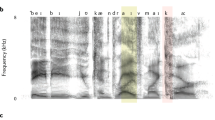Abstract
Human languages use an amazing variety of subtly different speech sounds to convey meaning. With the exception of sign languages that are used and developed by communities of deaf people, all human languages use sound as the primary signal. The sounds, or more accurately the differences between sounds, that humans use for distinguishing meanings can be very subtle. Two different sounds that would be perceived as identical by a speaker of one language might make an important distinction in meaning in another. For example, in the Bahing language of East Nepal, the word /m● r● / means “monkey”, while the word /m● r● means “man”. Speakers of neighboring and European languages alike are generally not able to perceive this distinction, an unlimited source of fun to the Bahing people.
Access this chapter
Tax calculation will be finalised at checkout
Purchases are for personal use only
Preview
Unable to display preview. Download preview PDF.
Similar content being viewed by others
References
Baldwin JM (1896) A new factor in evolution. The American Naturalist, 30: 441–451, 536–553. Reprinted In: Belew RK, Mitchell M (eds) Adaptive individuals in evolving populations: Models and algorithms (SFI Studies in the Sciences of Complexity, Vol XXVI), Addison Wesley, Reading MA, 1996
Berrah AR (1998) Évolution artificielle d’une société d’agents de parole: Un modèle pour l’émergence du code phonétique. Thèse de l’Institut National Polytechnique de Grenoble, Spécialité Sciences Cognitives
Berrah AR, Glotin H, Laboissière R, Bessière P, Boë L-J (1996) From form to formation of phonetic structures: An evolutionary computing perspective. In Fogarty T, Venturini G (eds) ICML’ 96 Workshop on Evolutionary Computing and Machine Learning, pp 23–29
Cooper FS, Delattre PC, Liberman AM, Borst JM, Gerstman LJ (1952) Some experiments on the perception of synthetic speech sounds. Journal of the Acoustical Society of America, 24: 597–606. Reprinted in: Fry DB (ed) Acoustic phonetics, Cambridge University Press, pp 258–272
de Boer B (1997) Generating vowels in a population of agents. In: Husbands P, Harvey I (eds) Proceedings of the Fourth European Conference on Artificial Life, MIT Press, Cambridge MA, pp 503–510
de Boer B (2000) Emergence of vowel systems through self-organisation AI Communications, 13: 27–39
de Boer B, Vogt P (1999) Emergence of speech sounds in a changing population. In: Floreano D, Nicoud J-D, Mondada F (eds) Proceedings of the Fifth European Conference on Artificial Life, ECAL 99 (Lecture Notes in Artificial Intelligence, Volume 1674), Springer-Verlag, Berlin, pp 664–673
Everett DL (1982) Phonetic rarities in Piraha. Journal of the International Phonetic Association, 12: 94–96
Firchow I, Firchow J. (1969) An abbreviated phoneme inventory. Anthropological Linguistics, 11: 271–276
Frieda EM, Walley AC, Flege JE, Sloane ME (1999) Adults’ perception of native and nonnative vowels: Implications for the perceptual magnet effect. Perception Psychophysics, 61: 561–577
Glotin H (1995) La vie artificielle d’une société de robots parlants: émergence et changement du code phonétique. DEA sciences cognitives — Institut National Polytechnique de Grenoble
Glotin H, Laboissière R (1996) Emergence du code phonétique dans une societe de robots parlants. Actes de la Conference de Rochebrune 1996: du Collectif au social, Ecole Nationale Supérieure des Telecommunications, Paris
Labov W (1994) Principles of linguistic change. Blackwell, Oxford
Ladefoged P, Maddieson I (1996) The sounds of the world’s languages. Blackwell, Oxford
Lakoff G (1987) Women, fire, and dangerous things: what categories reveal about the mind. Chicago University Press, Chicago
Lieberman P, Crelin ES (1971) On the speech of Neanderthal man. Linguistic Inquiry, 2: 203–222
Liljencrants L, Lindblom B (1972) Numerical simulations of vowel quality systems: The role of perceptual contrast. Language, 48: 839–862
Lindblom B, MacNeilage P, Studdert-Kennedy M (1984) Self-organizing processes and the explanation of language universals. In: Butterworth B, Comrie B, Dahl Ö (eds) Explanations for language universals, Walter de Gruyter, Berlin, pp 181–203
Lindblom B, Maddieson I (1988), Phonetic universals in consonant systems. In: Larry M, Hyman C, Li N (eds) Language, speech and mind. Routledge, London, pp 62–78
Maddieson I (1984) Patterns of sounds. Cambridge University Press
Maddieson I, Precoda K (1990) Updating UPSID In: UCLA Working Papers in Phonetics, 74, pp 104–111
Mantakas M, Schwartz JL, Escudier P (1986), Modele de prediction du’ deuxiéme formant effectif’ F2 — application à l’étude de la labialité des voyelles avant du français. In: Proceesings of the 15 th journées d’ étude sur la parole Société Française d’Acoustique, pp 157–161
Redford MA, Chun Chi Chen, Miikkulainen R (1998) Modeling the emergence of syllable systems. In Proceedings of the 20th Annual Meeting of the Cognitive Science Society (COGSCI-98, Madison, WI). Lawrence Erlbaum Associates, Hillsdale NJ, pp 882–886
Redford MA, Chun Chi Chen, Miikkulainen R (in press) Constrained emergence of universals and variation in syllable systems, Language and Speech
Ruhlen M (1994) The origin of language: Tracing the evolution of the mother tongue. Wiley, New York
Schwartz JL, Boë L-J, Vallée N, Abry C (1997a), Major trends in vowel system inventories. Journal of Phonetics, 25: 233–253
Schwartz JL, Boë L-J, Vallée N, Abry C (1997b), The dispersion-focalization theory of vowel systems. Journal of Phonetics, 25: 255–286
Sheldon SN (1974) Some morphophonemic and tone rules in Mura-Pirahã. International Journal of American Linguistics, 40: 279–282
Snyman JW (1970) An introduction to the !Xu⊕ (!Kung) language. Balkema, Cape Town
Snyman JW (1975) Zu/ohasi: fonologie woordeboek. Balkema, Cape Town
Steels L (1995) A self-organizing spatial vocabulary. Artificial Life, 2: 319–332
Steels L (1997) The synthetic modelling of language origins, Evolution of Communication, 1: 1–34
Vallée N (1994) Systèmes vocaliques: de la typologie aux prédictions, Thèse préparée au sein de 1’Institut de la Communication Parlée (Grenoble-URA CNRS no 368)
Vennemann T (1988) Preference laws for syllable structure. Mouton de Gruyter, Berlin
Wittgenstein L (1967) Philosophische Untersuchungen. Suhrkamp, Frankfurt
Editor information
Editors and Affiliations
Rights and permissions
Copyright information
© 2002 Springer-Verlag London Limited
About this chapter
Cite this chapter
de Boer, B. (2002). Evolving Sound Systems. In: Cangelosi, A., Parisi, D. (eds) Simulating the Evolution of Language. Springer, London. https://doi.org/10.1007/978-1-4471-0663-0_4
Download citation
DOI: https://doi.org/10.1007/978-1-4471-0663-0_4
Publisher Name: Springer, London
Print ISBN: 978-1-85233-428-4
Online ISBN: 978-1-4471-0663-0
eBook Packages: Springer Book Archive




